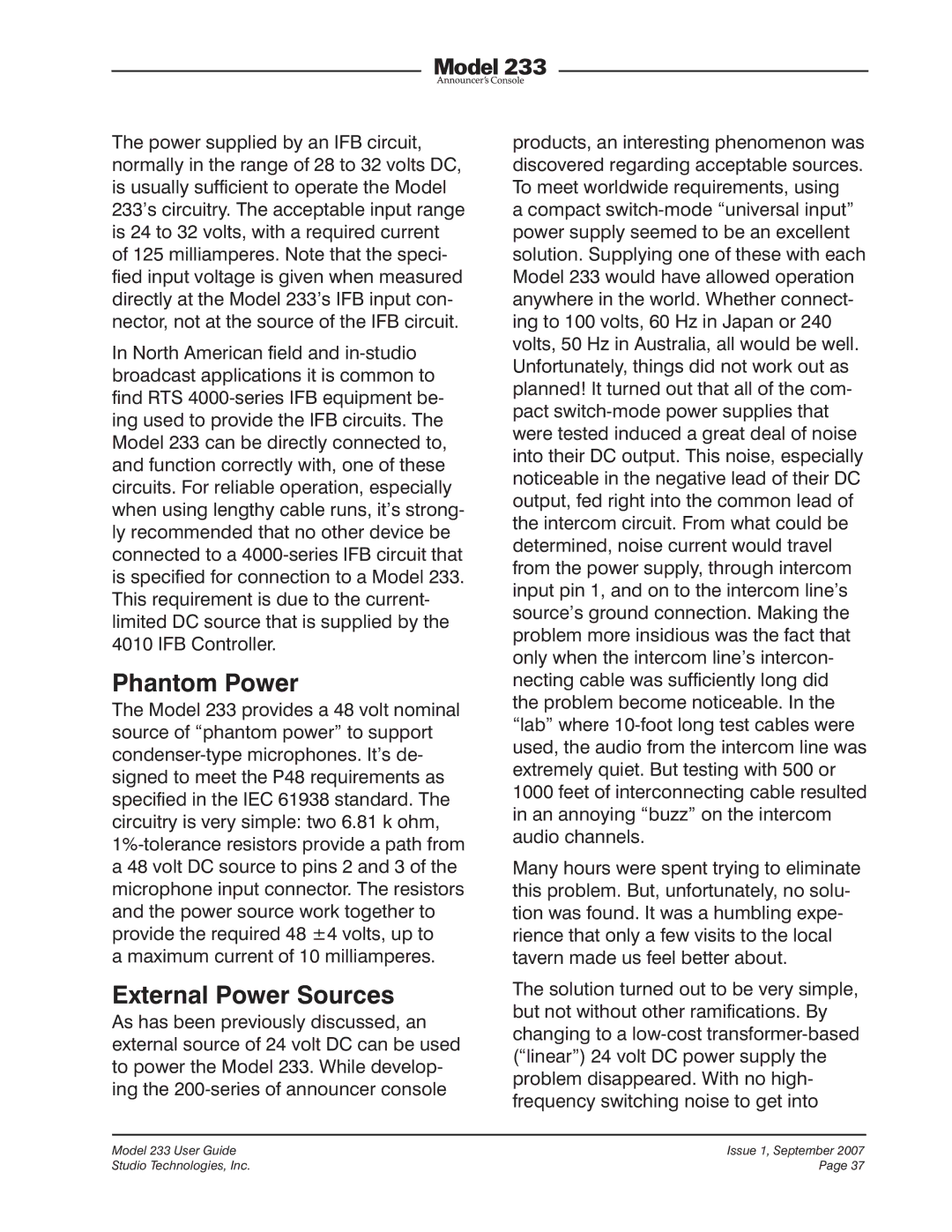The power supplied by an IFB circuit, normally in the range of 28 to 32 volts DC, is usually sufficient to operate the Model 233’s circuitry. The acceptable input range is 24 to 32 volts, with a required current of 125 milliamperes. Note that the speci- fied input voltage is given when measured directly at the Model 233’s IFB input con- nector, not at the source of the IFB circuit.
In North American field and in-studio broadcast applications it is common to find RTS 4000-series IFB equipment be- ing used to provide the IFB circuits. The Model 233 can be directly connected to, and function correctly with, one of these circuits. For reliable operation, especially when using lengthy cable runs, it’s strong- ly recommended that no other device be connected to a 4000-series IFB circuit that is specified for connection to a Model 233. This requirement is due to the current- limited DC source that is supplied by the 4010 IFB Controller.
Phantom Power
The Model 233 provides a 48 volt nominal source of “phantom power” to support condenser-type microphones. It’s de- signed to meet the P48 requirements as specified in the IEC 61938 standard. The circuitry is very simple: two 6.81 k ohm, 1%-tolerance resistors provide a path from a 48 volt DC source to pins 2 and 3 of the microphone input connector. The resistors and the power source work together to provide the required 48 ±4 volts, up to
a maximum current of 10 milliamperes.
External Power Sources
As has been previously discussed, an external source of 24 volt DC can be used to power the Model 233. While develop- ing the 200-series of announcer console
products, an interesting phenomenon was discovered regarding acceptable sources. To meet worldwide requirements, using a compact switch-mode “universal input” power supply seemed to be an excellent solution. Supplying one of these with each Model 233 would have allowed operation anywhere in the world. Whether connect- ing to 100 volts, 60 Hz in Japan or 240 volts, 50 Hz in Australia, all would be well. Unfortunately, things did not work out as planned! It turned out that all of the com- pact switch-mode power supplies that were tested induced a great deal of noise into their DC output. This noise, especially noticeable in the negative lead of their DC output, fed right into the common lead of the intercom circuit. From what could be determined, noise current would travel from the power supply, through intercom input pin 1, and on to the intercom line’s source’s ground connection. Making the problem more insidious was the fact that only when the intercom line’s intercon- necting cable was sufficiently long did the problem become noticeable. In the “lab” where 10-foot long test cables were used, the audio from the intercom line was extremely quiet. But testing with 500 or 1000 feet of interconnecting cable resulted in an annoying “buzz” on the intercom audio channels.
Many hours were spent trying to eliminate this problem. But, unfortunately, no solu- tion was found. It was a humbling expe- rience that only a few visits to the local tavern made us feel better about.
The solution turned out to be very simple, but not without other ramifications. By changing to a low-cost transformer-based (“linear”) 24 volt DC power supply the problem disappeared. With no high- frequency switching noise to get into

